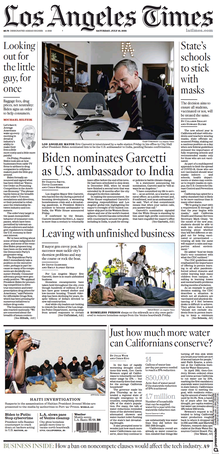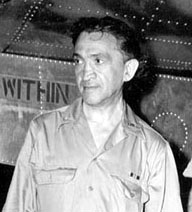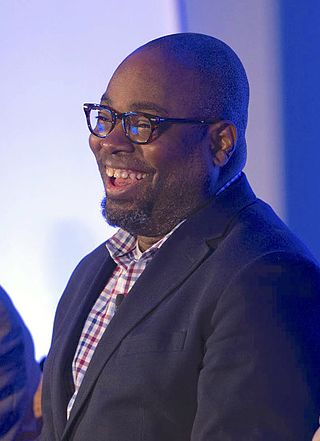
United Press International (UPI) is an American international news agency whose newswires, photo, news film, and audio services provided news material to thousands of newspapers, magazines, radio and television stations for most of the 20th century. At its peak, it had more than 6,000 media subscribers. Since the first of several sales and staff cutbacks in 1982, and the 1999 sale of its broadcast client list to its main U.S. rival, the Associated Press, UPI has concentrated on smaller information-market niches.

John Richard Hersey was an American writer and journalist. He is considered one of the earliest practitioners of the so-called New Journalism, in which storytelling techniques of fiction are adapted to non-fiction reportage. In 1999, Hersey's account of the aftermath of the atomic bomb dropped on Hiroshima, Japan, was adjudged the finest piece of American journalism of the 20th century by a 36-member panel associated with New York University's journalism department.

The Los Angeles Times, abbreviated as LA Times, is a daily newspaper that started publishing in Los Angeles in 1881. Based in the Los Angeles suburb of El Segundo since 2018, it is the sixth-largest newspaper by circulation in the United States. The publication has won more than 40 Pulitzer Prizes. It is owned by Patrick Soon-Shiong and published by the Times Mirror Company. The newspaper’s coverage has evolved more recently to emphasize California and especially Southern California stories.
The following are the Pulitzer Prizes for 1932.

William Leonard Laurence was a Jewish American science journalist best known for his work at The New York Times. Born in the Russian Empire, he won two Pulitzer Prizes. As the official historian of the Manhattan Project, he was the only journalist to witness the Trinity test and the atomic bombing of Nagasaki. He is credited with coining the iconic term "Atomic Age," which became popular in the 1950s. Infamously, he dismissed the destructive effects of radiation sickness as Japanese propaganda in The New York Times. Even though he had seen the effects first-hand, he had been on the War Department payroll, and was asked by United States military officials to do so in order to discredit earlier reports by independent journalist Wilfred Burchett, the first reporter on-site after the bombings.
Gareth Cook is an American journalist and editor. He was awarded a Pulitzer Prize in 2005 for “explaining, with clarity and humanity, the complex scientific and ethical dimensions of stem cell research.” Cook is a contributing writer for The New York Times Magazine, is also the series editor of The Best American Infographics and editor of Mind Matters, Scientific American's neuroscience blog. His writing has appeared in The New York Times Magazine, The Boston Globe, Wired, and Scientific American.
The following are the Pulitzer Prizes for 1946.

The Pulitzer Prize for Reporting was awarded from 1917 to 1947.
Mark Fritz is a war correspondent and author. A native of Detroit and graduate of Wayne State University, he won a Pulitzer Prize for International Reporting in 1995 for his stories concerning the Rwandan genocide.
Henry Payne is an American editorial cartoonist for The Detroit News. He also writes articles for the National Review. In 1987, Payne was a finalist for a Pulitzer Prize in Editorial Cartooning, and he won the Society of Professional Journalists' Excellence in Journalism Award in 2019 and 2022.
Walter Robert Mears was an American journalist, author, and educator. Mears worked for the Associated Press (AP) from 1956 until his retirement in 2001. In 1977, he won the Pulitzer Prize for National Reporting for his coverage of the 1976 United States presidential election. After retirement, he taught journalism at the University of North Carolina at Chapel Hill and at Duke University.
Alix Marian Freedman is an American journalist, and ethics editor at Thomson Reuters.
Gary Cohn is an American Pulitzer Prize-winning investigative reporter and adjunct professor at the University of Southern California Annenberg School for Communication and Journalism.

Gobind Behari Lal was an Indian-American journalist and independence activist. A relative and close associate of Lala Har Dayal, he joined the Ghadar Party and participated in the Indian independence movement. He arrived the United States on a scholarship to study at the University of California, Berkeley. Later, he worked as a science editor for the Hearst Newspapers. In 1937, he became the first Indian to win the Pulitzer Prize.

Stephen Henderson is an American journalist. Henderson won the 2014 Pulitzer Prize for commentary and the 2014 National Association of Black Journalists Journalist of the Year Award while writing for the Detroit Free Press.
Sandra Blakeslee is an American science correspondent of over four decades for The New York Times and science writer, specializing in neuroscience. Together with neuroscientist V. S. Ramachandran, she authored the 1998 popular science book Phantoms in the Brain: Probing the Mysteries of the Human Mind.
Nathan Solon Finney, who wrote under the name Nat S. Finney, was an American journalist. He spent long periods as a Washington correspondent for the Minneapolis Tribune and, later, the Buffalo Evening News. A specialist on economics and nuclear energy, he covered atomic tests in the Pacific, was the first journalist to visit Los Alamos National Laboratory, and was the first to report on Soviet missiles in Cuba.
Anthony Harry Leviero was an American journalist who spent over two decades as a reporter for The New York Times. He won the Pulitzer Prize for National Reporting in 1952.
Mark Schoofs is an American Pulitzer Prize-winning journalist and was the editor-in-chief of BuzzFeed News. He is also a visiting professor at the USC Annenberg School for Communication and Journalism.
Price Day (1907-1978) was a war correspondent for the Baltimore Sun who won a 1949 Pulitzer Prize for International Reporting.







